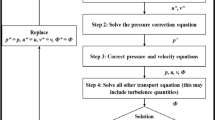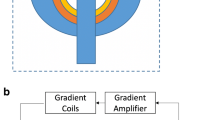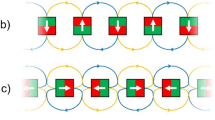Abstract
Background
Increasing numbers of patients with active implantable medical devices (AIMDs) require magnetic resonance (MR) examinations. The manufacturers are continuing to improve the MR compatibility of their AIMDs. To this end, a variety of measurement methods and numerical simulations are used to evaluate the risks associated with magnetic resonance imaging (MRI).
Objective
In this article, test methods used to investigate interactions between AIMDs with radio frequency fields and time-varying magnetic gradient fields are reviewed.
Materials and methods
A literature review of known test methods for radio frequency and gradient field exposure of AIMDs with leads, in particular for neurostimulators, cochlear implants, and implanted infusion pumps, is presented. The state of the art and promising methods are discussed.
Results
ISO/TS 10974 describes the design of high frequency and gradient injection setups to test conductive materials. A large number of sensor designs have been published to measure the induced voltages and currents through radio frequency and gradient fields and for monitoring AIMDs during MR examinations in in vitro tests.
Conclusion
The test methods should be planned to be as conservative as possible to cover the worst case scenario. However, in vitro measurements and computer simulation are far from being able to cover all possible configurations in their complexity and uniqueness. For safer MR examinations, current research recommends in vivo testing prior to MR, parallel radiofrequency transmission techniques, and new sequences with reduced energy input in the presence of AIMDs.
Zusammenfassung
Hintergrund
Immer mehr Patienten mit aktiven implantierbaren medizinischen Geräten (AIMDs) benötigen Magnetresonanz(MR)-Untersuchungen. Die Hersteller sind dabei, die MR-Kompatibilität ihrer AIMDs zu verbessern. Dafür werden verschiedenste Messmethoden und numerische Simulationen durchgeführt, um die Risiken in Bezug auf die Magnetresonanztomographie (MRT) zu evaluieren.
Ziele
Dieser Beitrag gibt einen Überblick über die verwendeten Testmethoden, welche die Interaktionen zwischen AIMDs mit Hochfrequenzfeldern und zeitveränderlichen magnetischen Feldgradienten untersuchen.
Material und Methoden
Ein Literaturüberblick über die bekannten Testmethoden für Feldgradienten- und Hochfrequenzexposition von AIMDs mit Anschlussleitungen, insbesondere bei Neurostimulatoren, Cochlea-Implantaten und implantierten Arzneimittelpumpen, wird präsentiert. Der Stand der Technik und vielversprechende Verfahren werden diskutiert.
Ergebnisse
ISO/TS 10974 beschreibt das Design von Hochfrequenz- und Gradienteninjektionsaufbauten für konduktive Materialtests. Zur Messung der induzierten Spannungen und Ströme durch Hochfrequenz- und Gradientenfelder sowie zur Überwachung der AIMDs während MR-Untersuchungen bei In-vitro-Tests wurde eine Vielzahl von Sensordesigns publiziert.
Schlussfolgerung
Die Testmethoden sind so konservativ wie möglich ausgelegt und müssen den ungünstigsten Fall abdecken. Allerdings sind In-vitro-Messungen und Computersimulation weit davon entfernt, jede mögliche Konfiguration in ihrer Komplexität und Einzigartigkeit zu erfassen. Für sicherere MR-Untersuchungen werden in der rezentesten Forschung In-vivo-Testung vor der MR-Untersuchung, parallele Hochfrequenzsendetechniken und neue Sequenzen mit reduziertem Energieeintrag in der Anwesenheit von AIMDs vorgeschlagen.



Similar content being viewed by others
References
Angelone LM, Ahveninen J, Belliveau JW, Bonmassar G (2010) Analysis of the role of lead resistivity in specific absorption rate for deep brain stimulator leads at 3T MRI. Ieee Trans Med Imaging 29:1029–1038. https://doi.org/10.1109/TMI.2010.2040624
Barbier T, Aissani S, Weber N, Pasquier C, Felblinger J (2018) A novel MR-compatible sensor to assess active medical device safety: stimulation monitoring, rectified radio frequency pulses, and gradient-induced voltage measurements. Magn Reson Mater Phys Biol Med 31:677–688. https://doi.org/10.1007/s10334-018-0682-z
Barbier T, Piumatti R, Hecker B, Odille F, Felblinger J, Pasquier C (2014) An RF-induced voltage sensor for investigating pacemaker safety in MRI. Magn Reson Mater Phys Biol Med 27:539–549. https://doi.org/10.1007/s10334-014-0437-4
Cabot E, Lloyd T, Christ A, Kainz W, Douglas M, Stenzel G, Wedan S, Kuster N (2013) Evaluation of the RF heating of a generic deep brain stimulator exposed in 1.5 T magnetic resonance scanners. Bioelectromagnetics 34:104–113. https://doi.org/10.1002/bem.21745
Corcoles J, Zastrow E, Kuster N (2017) Optimization-based strategy in multiple-channel magnetic resonance systems operating at 128 MHz to reduce radiofrequency heating induced by active implantable medical devices. XXXIInd General Assembly and Scientific Symposium of the International Union of Radio Science (URSI GASS), 2017 IEEE, Montreal, QC, pp 1–3
Córcoles J, Zastrow E, Kuster N (2017) On the estimation of the worst-case implant-induced RF-heating in multi-channel MRI. Phys Med Biol 62:4711–4727. https://doi.org/10.1088/1361-6560/aa641b
Eryaman Y, Kobayashi N, Moen S, Aman J, Grant A, Vaughan JT, Molnar G, Park MC, Vitek J, Adriany G, Ugurbil K, Harel N (2019) A simple geometric analysis method for measuring and mitigating RF induced currents on deep brain stimulation leads by multichannel transmission/reception. Neuroimage 184:658–668. https://doi.org/10.1016/j.neuroimage.2018.09.072
Feng S, Wang Q, Wen C, Zheng J, Kainz W, Chen J (2018) Simplified transfer function assessment of Implantable leads for MRI safety evaluations. IEEE Trans Electromagn Compa. https://doi.org/10.1109/TEMC.2018.2867814
Golestanirad L, Kirsch J, Bonmassar G, Downs S, Elahi B, Martin A, Iacono M‑I, Angelone LM, Keil B, Wald LL, Pilitsis J (2019) RF-induced heating in tissue near bilateral DBS implants during MRI at 1.5T and 3T: The role of surgical lead management. Neuroimage 184:566–576. https://doi.org/10.1016/j.neuroimage.2018.09.034
ISO/TS 10974:2012(E) (2012) Assessment of the safety of magnetic resonance imaging for patients with an active implantable medical device
Kuehn S, Kuster N, Munz O, Cabanes M (2018) In-vitro measurement system for induced voltages in medical implants in magnetic resonance imaging. IEEE International Symposium on Electromagnetic Compatibility and 2018 IEEE Asia-Pacific Symposium on Electromagnetic Compatibility (EMC/APEMC), 2018 IEEE, Suntec City, Singapore, pp 80–81
Liu J, Zheng J, Wang Q, Kainz W, Chen J (2018) A transmission line model for the evaluation of MRI RF-induced fields on active Implantable medical devices. Ieee Trans Microw Theory Tech 66:4271–4281. https://doi.org/10.1109/TMTT.2018.2851975
Liu J, Zheng J, Zeng Q, Wang Q, Rondoni J, Olsen J, Kainz W, Chen J (2018) Investigations on tissue-simulating medium for MRI RF safety assessment for patients with active Implantable medical devices. IEEE Trans Electromagn Compat. https://doi.org/10.1109/TEMC.2018.2847909
Luechinger R, Zeijlemaker VA, Pedersen EM, Mortensen P, Falk E, Duru F, Candinas R, Boesiger P (2005) In vivo heating of pacemaker leads during magnetic resonance imaging. Eur Heart J 26:376–383. https://doi.org/10.1093/eurheartj/ehi009
Mattei E, Censi F, Triventi M, Napolitano A, Genovese E, Cannatà V, Calcagnini G (2015) An optically coupled sensor for the measurement of currents induced by MRI gradient fields into endocardial leads. Magn Reson Mater Phys Biol Med 28:291–303. https://doi.org/10.1007/s10334-014-0463-2
Missoffe A, Aissani S (2018) Experimental setup for transfer function measurement to assess RF heating of medical leads in MRI: validation in the case of a single wire: transfer function measurement setup. Magn Reson Med 79:1766–1772. https://doi.org/10.1002/mrm.26773
Nordbeck P, Weiss I, Ehses P, Ritter O, Warmuth M, Fidler F, Herold V, Jakob PM, Ladd ME, Quick HH, Bauer WR (2009) Measuring RF-induced currents inside implants: Impact of device configuration on MRI safety of cardiac pacemaker leads. Magn Reson Med 61:570–578. https://doi.org/10.1002/mrm.21881
Park S‑M, Kamondetdacha R, Nyenhuis JA (2007) Calculation of MRI-induced heating of an implanted medical lead wire with an electric field transfer function. J Magn Reson Imaging 26:1278–1285. https://doi.org/10.1002/jmri.21159
Serano P, Angelone LM, Katnani H, Eskandar E, Bonmassar G (2015) A novel brain stimulation technology provides compatibility with MRI. Sci Rep. https://doi.org/10.1038/srep09805
Shellock FG, Crivelli R, Venugopalan R (2008) Programmable infusion pump and catheter: evaluation using 3‑tesla magnetic resonance imaging: infusion pump and catheter evaluated at 3‑tesla. Neuromodulation. Technol Neural Interface 11:163–170. https://doi.org/10.1111/j.1525-1403.2008.00162.x
Tandri H, Zviman MM, Wedan SR, Lloyd T, Berger RD, Halperin H (2008) Determinants of gradient field-induced current in a pacemaker lead system in a magnetic resonance imaging environment. Heart Rhythm 5:462–468. https://doi.org/10.1016/j.hrthm.2007.12.022
Tokaya JP, Raaijmakers AJE, Luijten PR, Bakker JF, van den Berg CAT (2017) MRI-based transfer function determination for the assessment of implant safety: MRI-based transfer function determination for the assessment of implant safety. Magn Reson Med 78:2449–2459. https://doi.org/10.1002/mrm.26613
Turk EA, Kopanoglu E, Guney S, Bugdayci KE, Ider YZ, Erturk VB, Atalar E (2012) A simple analytical expression for the gradient induced potential on active implants during MRI. Ieee Trans Biomed Eng 59:2845–2851. https://doi.org/10.1109/TBME.2012.2212190
Zanchi MG, Venook R, Pauly JM, Scott GC (2010) An optically coupled system for quantitative monitoring of MRI-induced RF currents into long conductors. Ieee Trans Med Imaging 29:169–178. https://doi.org/10.1109/TMI.2009.2031558
Zeng Q, Wang Q, Zheng J, Kainz W, Chen J (2018) Evaluation of MRI RF electromagnetic field induced heating near leads of cochlear implants. Phys Med Biol 63:135020. https://doi.org/10.1088/1361-6560/aacbf2
Author information
Authors and Affiliations
Corresponding author
Ethics declarations
Conflict of interest
J. Felblinger is a shareholder in Healtis. This has no effect on the content of the current publication. S. Aissani and E. Laistler declare that they have no competing interests.
For this article no studies with human participants or animals were performed by any of the authors. All studies performed were in accordance with the ethical standards indicated in each case.
The supplement containing this article is not sponsored by industry.
Rights and permissions
About this article
Cite this article
Aissani, S., Laistler, E. & Felblinger, J. MR safety assessment of active implantable medical devices. Radiologe 59 (Suppl 1), 40–45 (2019). https://doi.org/10.1007/s00117-019-0541-6
Published:
Issue Date:
DOI: https://doi.org/10.1007/s00117-019-0541-6




